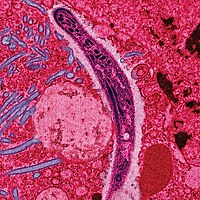
Photo from wikipedia
Staphylococcus aureus (S. aureus) strains with considerable genetic and phenotypic differences have previously been identified. The economic and epidemiologic impact of S. aureus mastitis has been investigated, but none of… Click to show full abstract
Staphylococcus aureus (S. aureus) strains with considerable genetic and phenotypic differences have previously been identified. The economic and epidemiologic impact of S. aureus mastitis has been investigated, but none of these studies took differences between strains into account. Here we aimed to investigate how differences between S. aureus strains affect the economic and epidemiologic outcome of various intervention strategies against clinical and subclinical intramammary infections. Five S. aureus strains were modelled using a stochastic bio-economic model simulating a dairy herd of 200 cows using single-day time steps. The strain characteristics of the five simulated S. aureus strains (general, contagious, spill-over, clinical and persistent) were based on divergent phenotypes as described in literature. Outcomes of the model included incidence (both clinical and subclinical), number of antibiotic treatment days, number of culled cows, and net income. Intervention strategies against clinical and subclinical intramammary infections were based on (variations of) intramammary antibiotic treatment, testing, and culling. Both single and multiple pathogen (intramammary infection caused by S. aureus, Escherichia coli, and non-aureus staphylococci) scenarios were simulated to determine the effect of the five S. aureus strains on the impact of 19 different intervention strategies. The results showed that the incidence (both clinical and subclinical), number of treatment days, number of culled cows, and net income varied considerably for the different S. aureus strains. Comparison of the model outcomes within and between strains showed that for most intervention strategies the relative impact differed per strain. However, the intervention strategy with the best outcome for most variables and strains was the culling of cows with a recovery probability lower than 50%. This shows that the relative economic and epidemiologic impact of most of the modelled intervention strategies were strain-dependent, while some intervention strategies were not strain-dependent. From this, we conclude that, depending on the intervention strategy applied on a farm, it could be advantageous to type S. aureus to determine whether it would be economically and epidemiologically beneficial for the existing intervention strategy to be changed.
Journal Title: Preventive veterinary medicine
Year Published: 2021
Link to full text (if available)
Share on Social Media: Sign Up to like & get
recommendations!